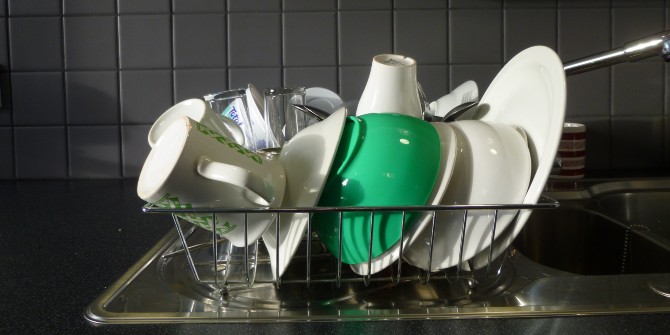The pandemic has left many women in the US with no option but to quit their jobs or cut their hours. For a lot of them, rejoining the workforce will not be easy. Aliya Hamid Rao (LSE) explains how family dynamics and privatised caregiving make the challenge so hard.
The current spate of job losses has been cutesily termed the “shecession” (a predictable twin of the “man-cession” of 2007-2009). Jobs being lost during the global pandemic have been predominantly done by women of all races and people of colour. The December 2020 jobs report showed that 140,000 US jobs were lost, of which most were done by women. At the same time, women have been cutting back on hours spent in paid work, and even quitting their jobs as they manage the increase in caregiving that the pandemic has wrought.
Women’s labour force participation in the US is now at its deepest trough in over three decades. Job loss combines with acute burdens of caregiving due to national lockdowns to produce a perfect maelstrom. It is poised to catastrophically impact women’s employment for years.
What happens to women who lose their jobs in the years to come will be anything but cute. After their job loss, family dynamics in the home will be extremely important in shaping how women eventually re-enter the labour force. The ideological and practical requirements of caregiving, especially childcare, will loom large in these processes.
The families of unemployed women downplayed women’s paid work by minimising what it meant for their finances
To understand how men and women experience unemployment, including how they search for jobs, I have studied dozens of unemployed men, and unemployed women, their husbands, their wives, and their children in the US. I have also spent time with some of these families in their homes, and gone on trips to the library, zoo, school events, and even one cross-state road trip (my research was conducted pre-pandemic). The unemployed people I spoke with were heterosexual, married parents in the US professional middle class. They held a bachelor’s degree or higher, and worked in professions like law, senior management, and academia. They represent a new group of workers experiencing unemployment.
Unemployment can be catastrophic for the working class and working poor in the US. Since the Great Recession, it has become clear that unemployment is now also a recurrent fixture in the lives of privileged workers who have usually been far more protected from it.
The gendered pressure to find a job was also immense for men
I found that the families of unemployed women downplayed women’s paid work by minimising what it meant for their finances. This happened even when women had earned as much or more than their husbands. The husband of an unemployed woman who had earned the same as him told me, “We live very modestly… we always thought it important that we could keep our house on one income.” Because the importance of women’s unemployment was downplayed, their re-employment was not seen as an urgent problem. Instead, family dynamics meant that unemployed women were expected to focus their days on taking over the childcare and housework that had been more equally shared between the two partners when women were employed. An unemployed woman told me, “My husband would take more turns doing things. He would help with the dinner, meals, or cleaning. Now that I’m not working, it’s not even the realm of even anything he’s thinking about.”
Ideologies of intensive motherhood combined with an unsupportive childcare infrastructure to shape the experiences of the unemployed women in my study. The women I interviewed explained that it was hard to justify paying for childcare when they were unemployed. Their new “doing it all” meant that they tried to search for a job while managing everything at home. But because the search process for jobs like the ones for which they were vying is time and energy-consuming, filled with crafting individualised cover letters, doing research on potential employers, networking, and prepping for interviews, they made limited headway. Women’s unemployment pushed these families to re-inscribe traditional gender norms.
Privileged women trying to re-enter the workforce after an absence can expect three bleak pathways
As I learned, it was a different story for unemployed men. Men’s unemployment was seen in their families as a grave problem that needed an immediate solution – a new job equivalent to the one men had lost. Unemployed men’s time – including when the men had earned less than their wives – was protected from housework and childcare. It was protected to allow men to focus on job-searching. A wife of an unemployed man laughed as she recounted what she thought of as an absurd experience. She came home at around nine at night after a long day at work and her unemployed husband asked her “‘What’s for dinner?’” She described her frustrated response, exclaiming “‘I don’t know! You’re home all day, what’s for dinner?” An unemployed man I interviewed offered a rationalisation of why he had not started doing more housework, “I’m home to find a job. I’m not home to do [chores].” Men, more than women, were able to protect their time to focus on job-searching and re-employment. But the gendered pressure to find a job was also immense for them. In a small voice, another man told me: “Back here is a little voice: ‘You’re a bum.’”

Women’s unemployment can easily upset the hard-fought, but very fragile, walk towards gender equality. Privileged women like the one in my study have been assumed to be the ones most strongly positioned to break glass ceilings. But how their professional pathways unfold after an absence from paid work serves as a cautionary tale of squandered professional potential. In two important books, sociologists Pamela Stone and Meg Lovejoy have shown that privileged women trying to re-enter the workforce after an absence can expect three bleak pathways. They can expect to “change course,” where they redirect their job-search into lower paying occupations than the one in which they had previously held jobs. They can expect to “course-correct,” where they re-enter their former occupations but in precarious roles, usually without benefits. And, finally, in the only optimistic pathway, they can expect a “comeback,” where they re-enter their former occupation in a full-time role.
The jobs that women have lost will have devastating consequences for their professional trajectories, lifetime earnings, and even gender inequality. Their job loss combines with gendered caregiving obligations to shape their family’s responses. Ultimately, these responses are undergirded by the ideological and practical context of privatised caregiving in the US. This is detrimental for women’s participation in the labour force. The women in this piece are privileged, and far more able to afford the costs of privatised caregiving. The situation will be dire for disadvantaged women who will likely face far worse re-employment prospects. An adequate social infrastructure—for instance ensuring robust policy support around caregiving—could go a long way in reining in some of the worst impacts of the deluge of women’s job losses since the spring of 2020.
This post represents the views of the author and not those of the COVID-19 blog, nor LSE.





